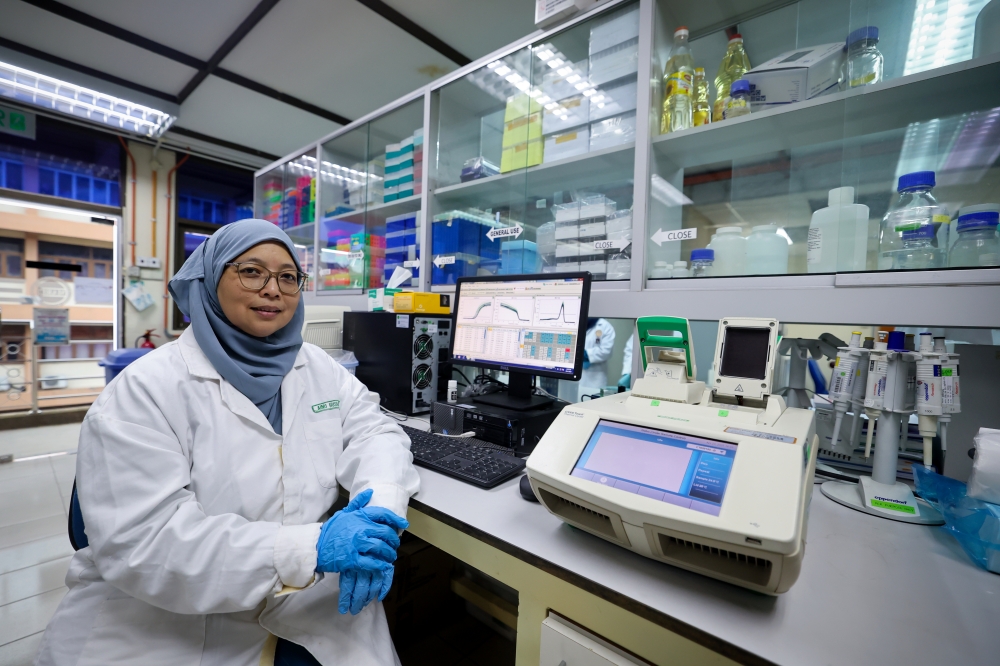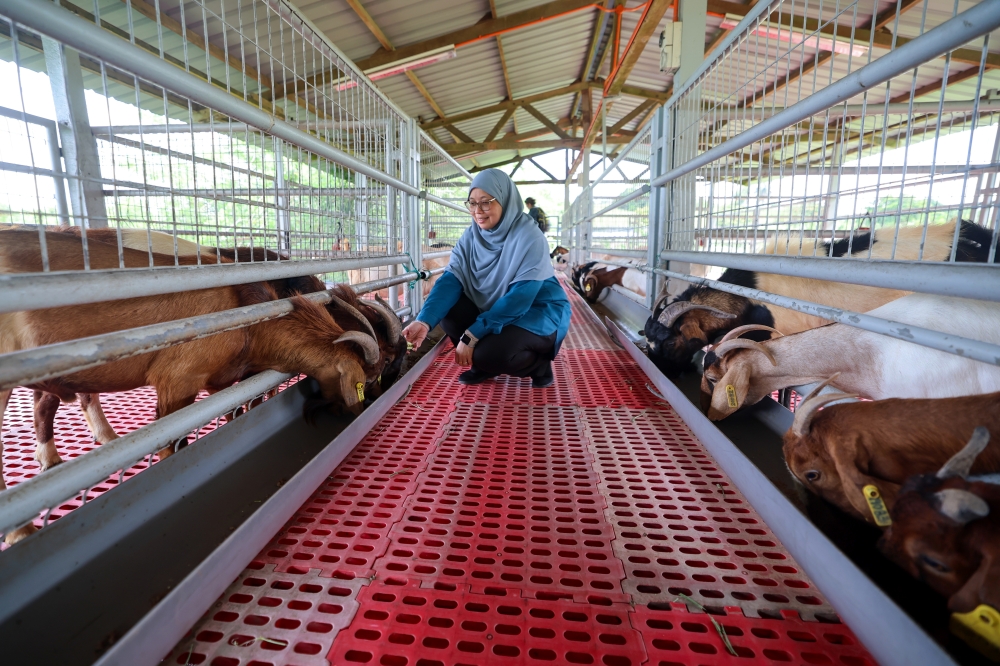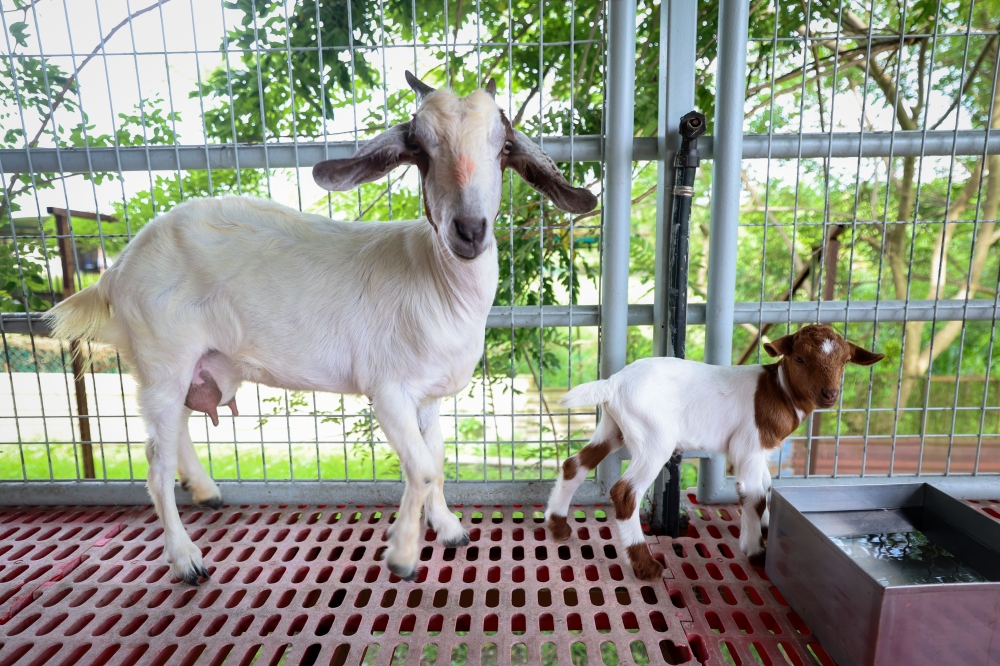REMBAU, May 24 — In a wooden paddock sitting at the edge of a sun-beaten field in Rembau, Negeri Sembilan, livestock farmer Kamaruzaman Budin walks slowly toward five black and brown goats huddled nervously in the corner of their new pen.
With black, brown or mixed coats, of which three are short-eared and lean, their diminutive size is striking compared to the goats in the neighbouring pens, some of whom are taller than the railings.
Kamaruzaman, 67, better known as Kamal, points to a brown goat with a black line along its spine. Then he points to another, then another.
“Ha, this is ‘Kacang’,” he tells Bernama. “One, two, three ‘Kacang’.”
Kamaruzaman Budin at his Katjang goat farm during a recent interview. — Bernama pic
He had just acquired these five goats from another farmer. The seller claimed all five were purebred Katjang, or ‘Kacang’ as it is known colloquially (‘kacang’ means peanut in Bahasa Malaysia). Katjang (Capri aegagrus hircus) is the only goat breed native to Malaysia.
However, Kamal has already noticed that two of the five have non-Katjang traits with their long droopy ears. The rest look like they may be purebreds but he won’t be sure until Malaysian Agricultural Research and Development Institute (Mardi) scientists, who have been seeking and buying Katjang goats all over Malaysia, can verify their lineage via DNA testing.
Nevertheless, Kamal considers himself lucky to have gotten them as Katjang goats are becoming rare.
”The Katjang isn’t big. And when it’s not big, people aren’t interested in raising it. They prefer imported breeds because they are big and their meat ratio is good,” he explains. “But the good thing about the Katjang is that it is resilient and resistant to diseases.”
That resilience, long taken for granted, has become a matter of national concern.
After decades of uncontrolled crossbreeding with imported breeds, the Katjang is facing extinction via genetic dilution. As Malaysia struggles with food insecurity, climate change and increasing food import costs, the resilience of the Katjang may hold the key to the solution. Scientists are racing to conserve the Katjang by employing traditional and new methods using DNA technology.
The hardy goat
Long before Malaysia imported refrigerated meats and had industrial farms, the Katjang goat was a familiar sight in villages. Farmers would let them forage along roadsides and in the fields and forests. Hardy and not fussy about what it ate or where it slept, the animal has had many generations to evolve and develop a tolerance for Malaysia’s heat and humidity, and against the parasites and diseases that are endemic in the country.
“The Katjang is, you know, it’s here for a reason. It’s indigenous for a reason. It’s the best here,” says Dr Ainu Husna M. S. Suhaimi, principal research officer of Advanced and Reproductive Technologies at Mardi. “Now in Malaysia, we are realising that our local animals are still the most sustainable.”

Lead researcher of the Advanced and Reproductive Technology Programme at the Malaysian Agricultural Research and Development Institute (MARDI), Dr Ainu Husna M. S. Suhaimi, speaking to Bernama about the Katjang goat. — Bernama pic
The Katjang’s physical traits are distinct. Other than their small size, they have sleek black and/or dark brown coats, short and tapered upright ears, and straight and tapered upright horns. Adult males typically weigh under 30 kilogrammes, far less than the imported Boer or Jamnapari goats, which can reach twice that size. Although the Katjang breed is very fertile, with twin births, its milk production is only enough for the kids. It is slower to grow to full size and is not very meaty.
Because of these perceived disadvantages, the Katjang was gradually sidelined. Kamal remembers when he first started his farm in 1985, he only raised Katjang goats. Then slowly the focus shifted to goats with higher meat yield and from 2004 onwards, Boer goats with their impressive build and meat production were imported from South Africa and Australia. However, it had an oft-fatal flaw — it could not deal with Malaysia’s climate, resulting in a 20 per cent mortality rate, according to Mardi.
“If you talk to farmers (now), what they want is survivability. So local is the most survivable and adaptable so we know there is a demand for (local breeds) but the local breeds are still small,” adds Dr Ainu Husna.
To offset this, the government at the time encouraged farmers to crossbreed with the resilient Katjang. At first, crossbreeding seemed like a win. Hybrids grew faster and bigger, and fetched higher prices. But the lack of a proper breeding programme caused the Katjang gene pool to become diluted over time. Any pure Katjang goats that remained were used again and again, causing inbreeding and resulting in smaller and unhealthy goats.

Lead researcher of the Advanced and Reproductive Technology Programme at the Malaysian Agricultural Research and Development Institute (Mardi), Dr Ainu Husna M. S. Suhaimi feeding goats carefully reared for DNA technology research to ensure food security at Mardi Serdang. — Bernama pic
Following a survey conducted by the Department of Veterinary Services (DVS) from 2001 to 2002, the Katjang was classified as being at risk of extinction and the United Nations’ Food and Agriculture Organisation (FAO) listed its status as unknown. Other local breeds of livestock are also facing extinction, including the KK (Kedah-Kelantan) cow, while one breed may be extinct. Mardi believes the indigenous Malin sheep (Ovis aries) is extinct as a breed.
Over two decades later, the Katjang’s current numbers are unknown. Mardi has a herd of about 100 Katjang goats at its farm in Kluang, Johor, and its researchers are always on the search for more.
Small goat, big role
At first glance, saving the Katjang might seem odd as it is a livestock breed, reared to be eaten. After all, if one breed of goat is extinct, can’t Malaysia just get other goats from elsewhere? Livestock experts say it is not that simple.
Although the goat industry is small in Malaysia, there is a consistent market for it, especially among Muslims and Hindus. Muslims sacrifice goats and distribute the meat, called mutton here, during religious events like qurban during Aidiladha and aqiqah, which is to celebrate births, while Hindus, who refrain from eating beef, consume mutton as their red meat.
In 2023, the consumption of mutton, which includes goat and sheep meat, had increased to 1.4 kg per capita from 1.0 kg in 2022, while Malaysia’s self-sufficiency rate of the meat was 8.7 per cent, a drop from 10.7 the previous year. Malaysia spent RM8.5 million importing live goats and RM18.62 million on live sheep in 2023, and RM772.4 million on fresh, frozen and processed mutton. Market analysts predict goat meat will become more popular in the next decade as more people will seek it for its leanness and other nutritional benefits.
Depending on imports to meet food demand leaves Malaysia vulnerable to any shocks to the supply chain, as the COVID-19 pandemic, the war in Ukraine and recently, the India–Pakistan tensions showed. Meanwhile, local goat production is hampered by expensive feed, veterinary costs and a high mortality rate.
Universiti Kebangsaan Malaysia (UKM) ecological geneticist Dr Shairah Abdul Razak tells Bernama that the Malaysian livestock industry has been too focused on profits and higher meat yield, without considering issues like the impact of climate change on livestock.
“If we bring, like, sheep that have lots of meat from temperate countries, can they withstand (the heat)? Do you want to provide, you know, coolant for them the whole time you put them in the barn, for example,” she says. “In terms of nutrients, one of the important things about local breeds is that they… are not very (choosy).”
Researchers fear the Katjang will go the way of the Malin sheep, characterised by its light brown coarse wool, which they believe has been crossbred to extinction. However, Shairah thinks there may be a few pure-bred Malin sheep somewhere in Perak and Pahang.
“(Saving local breeds of livestock) is a form of — I like to use the word insurance, you know you might not see it (benefits) right now but you have to think for the long term. We want the resilience and the sustainability for the long term,” she adds.
DVS researcher and geneticist Dr Ernie Muneerah Mohd Adnan agrees.
“The Katjang goat may not match imported breeds in terms of size or meat production but in the context of climate change, its adaptability to these changes could become critical for the future of Malaysia’s livestock industry,” she writes in an email to Bernama.
The FAO reported that as of March 2018, 594 local agricultural breeds out of the 7,745 local breeds listed were extinct, while 26 per cent were considered “at risk of extinction” and 67 per cent as having “unknown” status. Should they disappear, so will the genetic traits needed to adapt to new environmental and economic realities.

One of the goats carefully reared for DNA technology research to ensure food security at MARDI Serdang.
Malaysianised goat
The core of the Katjang rescue mission lies in a growing effort to locate and collect the DNA of pure Katjang goats. The project combines old-fashioned legwork and husbandry with modern reproductive methods and genetic science.
Dr Ainu Husna’s team has been fanning out across rural areas in Peninsular Malaysia, visiting livestock farms and Orang Asli villages. When they spot an animal that looks promising, which is rare, they usually purchase the animals for their farm in Johor, collect samples and sequence their genome for desirable genetic markers.
Those with the desired traits will be used for selective breeding with other breeds, in the hopes of producing bigger and meatier, but also heat-tolerant and disease-resistant Katjang hybrids.
“We decided we need to have something in the middle,” she says. “Now, we are developing our pure Katjang–Boer mix or Malaysianised Boer. (For that) we need pure Katjang.”
The selective crossbreeding programme utilises natural and artificial fertilisation methods, using semen or eggs stored in liquid nitrogen. In general, Dr Ainu Husna says Mardi prefers to use natural breeding as it tends to be more successful, with an 80 per cent success rate. But if that is not possible, then researchers will use artificial insemination or in-vitro fertilisation. The DVS also has a biobank of Katjang sperm samples.
Having a ready supply of pure Katjang is necessary to refresh the genetic makeup of the Malaysianised Boer after several generations.
It is an expensive and time-consuming process, but one that could safeguard the breed and the country’s long-term food security.
“We might not see the challenge now, but as time goes by, the future might bring something that we are not prepared for if we don’t have this,” says Shairah, who is a senior lecturer at UKM.
Lack of awareness
Despite the urgency, the Katjang conservation project faces daunting barriers. Researchers tell Bernama they have trouble getting funding or cooperation for conservation efforts because people, including farmers, don’t understand the importance of saving local livestock breeds too, not just wildlife.
Without financial incentives or market demand for pure Katjang, most smallholders will not choose a smaller, slower-growing goat over a meatier import.
“Farmers often find it more profitable to raise imported or crossbred goats rather than purebred Katjang goats,” comments Dr Ernie Muneerah.
A few have floated the idea of subsidising farmers to not crossbreed their Katjang and keeping a registry of farmers with pure Katjang, which they can exchange for breeding. All want to fix the disconnect between scientists and farmers, and encourage farmers to use available resources such as Mardi and DVS to breed their livestock.
Meanwhile, under the glare of the late afternoon sun in Rembau, Kamal pours a bucket of feed into a blue trough. The goats shuffle over, nudging each other gently. He watches them for a moment, thoughtful.
“If we look at it in terms of disease, they’re really easy to raise … not many health issues. When it comes to changes, whether climate or something else, I think the Katjang goat will definitely survive,” Kamal says. — Bernama


